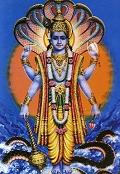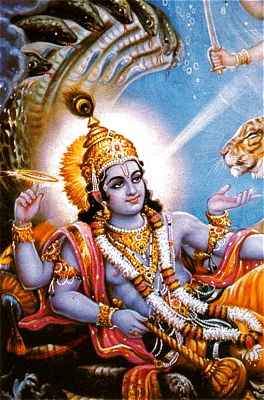 |
Vishnu at Muktinath
In Muktinath Vishnu is worshipped at the Temple
of the Lord of Salvation (Mukti Nath) and in a little
temple next to the Shiva Parvati Mandir. However central to the
meaning of Muktinath as a Hindu shrine is the veneration of Lord Vishnu
in the form of a Salagram stone.
There are many legends dating back more than 2000 years, which tell
of Vishnu turning into stone. All of these are closely connected to
Salagrama, the area along the Gandaki
River, also called Mukti Kshetra (Salvation Field).
The Compassionate Preserver
Vishnu is part of the Hindu Triad (Trimurti)
Brahma, Shiva and
Vishnu and represents the aspect of Supreme Reality that pervades
and sustains the created universe symbolized by Ohm. Vishnu is preserver
of the universe and the embodiment of goodness and mercy; of compassion.
The name Vishnu means 'one who pervades'; 'one who has entered into
everything.'
His consort
His consort is Lakshmi, the goddess
of beauty and fortune.
Vishnu's
form
As an icon Vishnu has four arms. The four arms indicate Vishnu's
omnipresence and omnipotence. In his right hand he holds the discus,
symbol of the cosmic mind and reminder of the wheel of time. His lower
right hand holds the conch
(sankh), symbol of the sound Ohm orgin of existence. The
sounds created from the conch is associated with the sound from the
creation of the universe.  From
this evolve the five elements. In his other hand he holds the bow
which is called shranga, the symbol of casual power
of illusion from which arises the universe. The arrows
are the sense which represent intellectual activities. In his upper
left hand, he holds a lotus (padma), the symbol for the
moving universe and the symbol of all things that are good (eternity,
prosperity, and purity). His lower left hand holds the mace
(gada), the symbol of the notion of individual existence.
The icons on his body also attruibutes to the greatness of the deity.
An example of this is the armlets he wears. These represent
the three aims of life; pleasure, success, and righteousness. The
other example is the earring shaped like monsters. They represent
the two methods of knowledge: the intellectual knowledge and the intuitive
perception. The power of the god is encased in the garland of victory
made from either five rows of flowers
or jewels, representing the five senses. From
this evolve the five elements. In his other hand he holds the bow
which is called shranga, the symbol of casual power
of illusion from which arises the universe. The arrows
are the sense which represent intellectual activities. In his upper
left hand, he holds a lotus (padma), the symbol for the
moving universe and the symbol of all things that are good (eternity,
prosperity, and purity). His lower left hand holds the mace
(gada), the symbol of the notion of individual existence.
The icons on his body also attruibutes to the greatness of the deity.
An example of this is the armlets he wears. These represent
the three aims of life; pleasure, success, and righteousness. The
other example is the earring shaped like monsters. They represent
the two methods of knowledge: the intellectual knowledge and the intuitive
perception. The power of the god is encased in the garland of victory
made from either five rows of flowers
or jewels, representing the five senses.
More
online information
For more backgrounds on Hindu
Deities & images see the Hindu Deities Index.
 Back
to top Back
to top
 Back to your previous page
Back to your previous page
Annapurna
- Muktinath
Map - Muktinath
History -
Muktinath Lama Wangyal - Travel
Info - Nuns
Picture
Gallery - Site
Map- MFI
Recommendations
Support
us with a donation

|
 |











